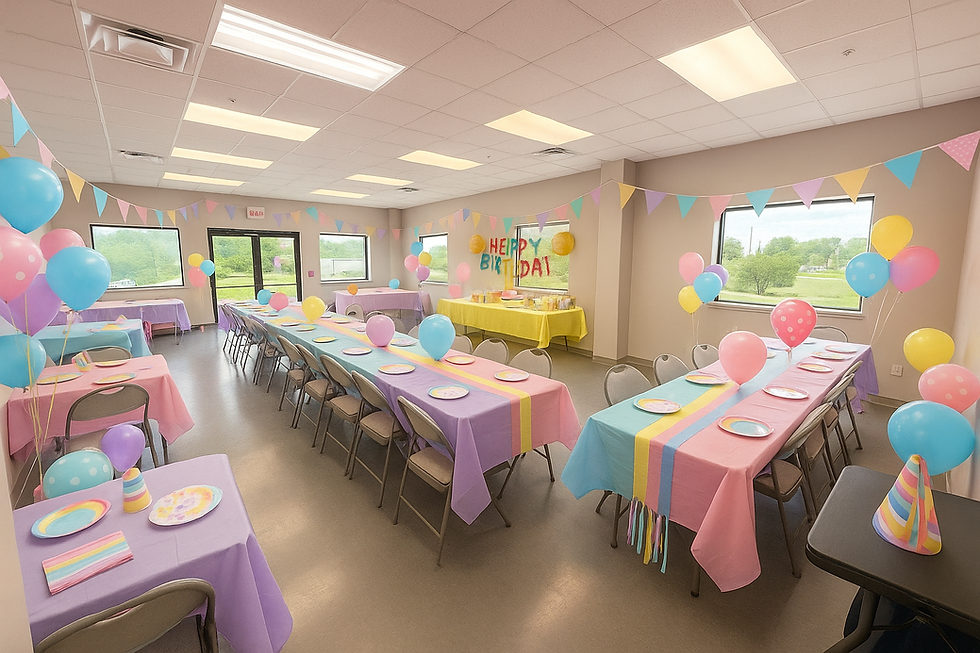Maximizing Space: How to Host Events for 200 in a Conference Center
- Ricky Maia
- Apr 2
- 3 min read
Updated: Jul 4
Hosting an event in a conference center for 200 people is a big task, but the right planning can make it seamless and enjoyable. Whether you're organizing a seminar, workshop, or celebration, your venue's layout and facilities are crucial. This guide will provide practical strategies to maximize space and enhance the attendee experience, making your events both enjoyable and efficient.
Choosing the Right Space Layout
Selecting the appropriate layout for your event is essential. Different arrangements suit different types of events, and knowing how to use them can improve the overall experience.
Theater Layout
With a theater layout, you can accommodate the maximum number of attendees for presentations or keynote speeches. By arranging chairs in rows facing the stage, everyone gets a clear view.
To enhance audience engagement, add a center aisle to facilitate easier movement during Q&A sessions. If you have a total of 200 seats, ensure that at least 75% of the audience is comfortably seated with an unobstructed view of the stage.
Classroom Layout
If interactive sessions and workshops are your focus, the classroom layout is your best bet. Providing tables for note-taking encourages more active participation.
Create designated breakout areas for group discussions. For instance, if you have 200 attendees, you can arrange for smaller groups of 10-15 for effective collaboration.
Banquet Layout
For social events, the banquet layout excels. Round tables encourage open conversation while being visually appealing.
Make sure there is enough space for food service and that attendees can navigate easily between tables. Typically, allow for at least 60-80 inches of space around each table.

Technology Setup
Having the right technology can elevate your event. It enhances engagement and ensures a smooth experience.
Audio-Visual Equipment
Invest in high-quality sound systems and projectors. Depending on your event, you may require microphones and larger screens for clear visibility.
Prior to the event, conduct thorough equipment tests to avoid technical glitches. A survey found that 74% of attendees found tech issues disruptive to the overall experience.
Wi-Fi Connectivity
Reliable Wi-Fi is vital for most events. Make sure your venue can handle 200 users online simultaneously without lag. Consider having multiple routers or Wi-Fi extenders to improve connection strength across the venue.
Provide charging stations throughout the space, as many attendees rely on their devices for information and networking. An estimated 60% of attendees expect easy access to charging options during events.
Catering Options
Quality food and beverage services greatly affect guest satisfaction.
Buffet vs. Plated Service
When choosing between buffet and plated service, consider the event type. Buffets encourage mingling, while plated service offers a formal atmosphere.
You can accommodate various dietary needs by serving gluten-free, vegan, and nut-free options. Research shows that 30% of attendees have specific dietary restrictions, so this consideration ensures everyone's needs are met.
Refreshments Throughout the Day
Providing snacks and beverages during breaks is crucial. Create designated refreshment stations to keep energy levels high and foster informal networking opportunities.
For instance, consider offering coffee, sandwiches, and fruit at regular intervals to rejuvenate your guests throughout the event.
Engagement Opportunities
Creating avenues for networking and interaction enhances the overall vibe of your event.
Networking Spaces
Set up specific areas for networking. Comfortable lounge spaces with informal seating help guests connect.
Having icebreakers or prompts can encourage conversations. For example, provide a few discussion topics—such as recent industry trends—to spark relationships among attendees.
Activities and Entertainment
Adding activities or entertainment makes your event memorable. Whether it's live performances, interactive polls, or engaging speakers, these elements enhance the experience.
Make sure your activities align with the event’s theme and cater to different engagement styles. This could mean including panel discussions, hands-on workshops, or even fun trivia related to your industry.
Event Day Logistics
On the event day, logistics play a crucial role in overall success.
Clear Signage
Provide clear, easy-to-read signage throughout the venue. This includes directions to restrooms, breakout rooms, and refreshment areas.
Color-coded signs can simplify navigation and reduce confusion, helping attendees feel more comfortable.
Staff Support
Having sufficient staff on hand is essential. Ensure team members can assist with inquiries and manage room transitions seamlessly.
A proactive team can troubleshoot issues quickly, allowing attendees to focus on networking and enjoying the event rather than logistical details.

Wrapping It Up
Successfully hosting events for 200 people in a conference center comes down to careful planning and detail orientation. By exploring various layout options, utilizing technology effectively, providing quality catering, encouraging engagement, and managing logistics expertly, you can create a remarkable experience for your guests.
When executed well, your event will leave a positive impression, ensuring that attendees will look forward to visiting again and contributing to a strong reputation for your venue.




Comments